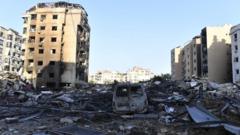**Amid escalating violence between Israel and Hezbollah, satellite data reveals more extensive destruction in two weeks than previously occurred in over a year. As the conflict continues, urgent humanitarian concerns are emerging in Lebanon.**
**Intensified Israeli Bombing Campaign in Lebanon: Analysis of Destruction and Humanitarian Impact**

**Intensified Israeli Bombing Campaign in Lebanon: Analysis of Destruction and Humanitarian Impact**
**Satellite imagery highlights the extensive damage caused by Israeli airstrikes in Lebanon, reflecting an escalating humanitarian crisis.**
Israel's current military operations in Lebanon have resulted in unprecedented damage, surpassing that seen in previous protracted conflicts with Hezbollah. According to a recent analysis by the BBC, satellite imagery indicates that over 3,600 buildings in Lebanon have either been damaged or destroyed between October 2 and October 14, 2024. This accounts for approximately 54% of the total damage recorded since the onset of hostilities with Hezbollah over a year ago.
The analysis was conducted by Corey Scher from City University of New York and Jamon Van Den Hoek from Oregon State University, utilizing radar satellite images to track changes in building structures indicative of damage. Environmental expert Wim Zwijnenburg from Pax for Peace expressed concerns about the consequences of the ongoing Israeli bombardment, stating that it appears to be creating "dead zones" in southern Lebanon that displace the population while hindering Hezbollah's operational capacity.
The current round of violence ignited when Hezbollah began launching rockets at northern Israel on October 8, 2023, following a deadly assault by Hamas on southern Israel. In response, Israeli forces escalated their military actions, claiming the objective was to dismantle Hezbollah's military infrastructure, particularly in southern Lebanon.
Recent reports indicate that Israeli airstrikes have increasingly targeted various locations, affecting central and northern Lebanon, including significant strikes in the Bekaa Valley and the suburbs of Beirut. The Israeli military claims these areas are crucial bases for Hezbollah operations. Notably, previous strikes were said to have targeted the Dahieh suburb in Beirut, allegedly housing Hezbollah’s command infrastructure.
A detailed assessment by the US-based Armed Conflict Location and Event Data Project highlighted at least 2,700 Israeli military actions in Lebanon between September 1 and October 11, 2024. In contrast, approximately 540 retaliatory strikes were reported from Hezbollah toward Israel, with each engagement involving multiple rockets and missiles.
The intensity of Israel's bombardment has precipitated mass displacements, with Lebanese officials revealing that nearly 1.3 million people are now internally displaced. Prime Minister Najib Mikati emphasized this situation as potentially the largest displacement in Lebanon's history.
In northern Israel, around 60,000 people have evacuated their homes due to near-daily Hezbollah attacks, which have sometimes reached as far south as Haifa, leading to casualties and destruction there.
Humanitarian organizations are expressing alarm about the escalating crisis, noting that adequate shelter for the displaced is insufficient. Gabriel Karlsson, the Middle East Manager for the British Red Cross in Beirut, described the situation as disastrous, with children subjected to sleeping outdoors amid deteriorating conditions.
As casualties on both sides mount—Lebanon reporting at least 2,350 dead and 10,000 injured, while Israel cites 60 fatalities and over 570 injuries—perspectives on the conflict remain polarized. Amos Yadlin, former head of Israeli military intelligence, attributed the violence to Hezbollah, advocating for a robust ground offensive to reclaim territories. Conversely, critics like Zwijnenburg warn of the humanitarian repercussions of military actions, highlighting the severe impact of airstrikes on civilian infrastructure and the overall humanitarian emergency unfolding in Lebanon.
The rapidly evolving situation calls for urgent international attention and concerted humanitarian efforts to alleviate the burgeoning crisis faced by the civilian population.


















